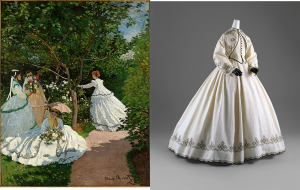
Claude Monet. Women in the Garden, 1866. Courtesy of Musée d’Orsay, Paris. Alongside embellished white dress from the exhibition
Impressionism, Fashion, and Modernity
The Metropolitan Museum of Art, New York City
26 February to 27 May 2013
Visited 12 May 2013
From PUNK to the sublime; the next-door exhibition, on that Sunday morning, was one I’d just missed at the Musée d’Orsay in Paris back in January, where tantalizingly the entrance banner was still up but the show had closed. So I was excited to see this joint venture (between museums in Paris, New York and Chicago) in its second incarnation, enjoying spacious galleries and perfect lighting that happily accommodated both paintings and textiles.
Even though my main professional interest is contemporary design in the context of design museums, as an avid gallery-goer I’m drawn to an exhibition such as this, which presents a sure-fire art-historical hit (there’s no better crowd pleaser than Impressionism) in a new light. And, from the point of view of Museum Studies this is an interesting show; mixing over 80 major figure paintings by Impressionists and their fashionable contemporaries, with historical artefacts and garments – the clothes and accessories depicted in paint on canvas – demonstrates a newly collaborative approach to exhibition curation.
Here’s evidence that the disciplines of design, fashion and cultural history can add another layer of understanding to our reading of fine art. For example, labels point out when these fashionable female figures may actually be dressed more casually, e.g. leaving off the requisite crinoline or petticoats due to the summer heat. To 21st-century eyes the women appear more than decently clothed; to their 19th-century contemporaries, these ladies’ behaviour would be considered louche, even scandalous; and it’s the fashion historians who can tell us this.
To be painted in such a manner points to, perhaps, a less than conventional relationship between artist and sitter. Here are images of muses, models, mistresses and wives. What’s interesting is how, through the act of looking, the artist hints at the relationship underpinning the depiction of these faces and clothes, for the artist has chosen to show the model in a provocative or compromising position. Whether embellishments on costumes and accessories are rendered in minute detail or simplified; whether the body, frock and fan are still or in motion; whether the eyes are fixed on the artist, or the face is averted; all these choices add up to a compelling narrative.
By highlighting fashion and setting (that’s the “Modernity” bit of the title), the curators are flagging up the vast amount of information that’s here to be read. Perhaps more so than in the Royal Academy’s Manet: Portraying Life, which concentrated on portraiture to the exclusion of more complex and animated compositions, this exhibition presents a much more complex rendition of this era.
Of course, the inclusion of historical garments and accessories, some of which are the actual objects depicted, drags us further in. Beyond the usefulness of these items as documentary evidence, for example, of the tiny stature of the women who fitted these garments, or the skill lavished on fine embroidery, the powerful notion that a unique object emits an aura seems to be case proven by this exhibition. Even though some of these objects were more ordinary than not in their day, by dint of their age and the fact they’re conserved in museum collections, they are now precious one-offs. When you see a fan so like the one held by the sick and dying Jeanne Duval, in Édouard Manet’s Lady with a Fan (Baudelaire’s Mistress) (1862), next to a vintage photograph of a woman holding an identical fan, and wearing a similarly voluminous white dress, that triangulation of painting, photograph and artefact creates an uncanny tension that resonates across centuries.
This crossover between objects hints at a transgression of the boundaries between the museum’s departmental “fiefdoms”, where a traditionally “hierarchy” of status has created an art versus artefact pecking order. That said, the Press Release refers to “ancillary material” (but it’s not clear if that’s everything that isn’t a painting or just the “ephemeral” works on paper, photographs, fashion illustrations, journals), so, still, not all museum objects are equal.
So, how did this show go down with the audience that morning? The galleries were busy, but as there was no closely defined route, the atmosphere was relaxed and discursive, with much cooing and questioning along the lines of, “is that the dress in that picture?” Perhaps connections could have been more closely drawn. Much was made of the corsets and the physicality of the dresses; it felt as if these women (and not just their ghosts) were close by. And along with a sympathetic mood for our forebears afflicted by such restrictive garments, there was a parallel (mild) envy, perhaps prompted by a wish to inhabit such beautiful garments.
This is a satisfying exhibition on so many levels (catch it in Chicago), with much to think about and admire. What a treat to see so many great 19th-century paintings in one place (drawn from collections worldwide) alongside enigmatic objects and sumptuous silks. This show expanded my understanding of the Impressionists too; along with their obsession with light, mark making and technique, it reveals them (and their peers) to be commentators on their modern world of latest modes and loosening morals.
Next stop The Art Institute of Chicago, from 26 June to 22 September
